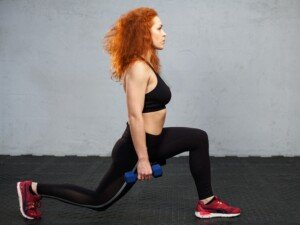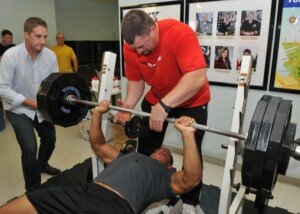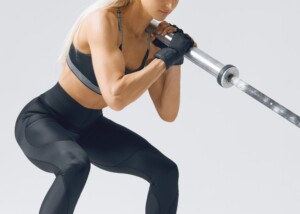
Will the walking lunge, done with a narrow or short space between the feet, with a barbell behind the neck, help you lose weight and is it safe?
Take a look at the image above. She is performing a lunge with a narrow or short stance while holding a barbell across her neck.
This exercise can be done walking from point A to point B. Or, it can be done in place, going up and down on the same leg repeatedly, or up and down with alternating legs.
There’s several reasons why this exercise – lunging with a barbell behind the neck, coupled with a short stance – is not optimal – whether your chief goal is weight loss, a firmer butt, firmer legs, strong legs, sculpted legs, a stronger core, a fitter lower back, what-have-you.
• The bar behind the neck. Go ahead, try to do walking or stationary up-and-down lunges with a bar behind your neck.
For some people, particularly deconditioned, this will be very uncomfortable or awkward.
• Plus, the position of the bar may encourage a forward lean of the spine, which is not what you want to be doing while performing lunges.
• One might say that the barbell behind the neck – which actually should be across the back and not the neck – is so that a heavy weight can easily be added to the lunges without tiring a person’s hands or arms.
However, some people do this with a light bar. Why not just hold, in one’s hands, that same amount of weight, with straight arms? This will make it less difficult to keep the spine straight, body upright.
• The other issue is the short distance between the feet: a narrow or short lunge.
This can be very uncomfortable for out-of-shape or overweight people.
• A wider stance, or more space between the feet, will be easier to perform and adhere to, while making it less likely you’ll suffer a joint strain.
• Finally, the narrow lunge makes it easier to slump forward, even if you don’t have a barbell across your back.
How to Correctly Perform Walking Lunges with Added Weight

Shutterstock/Artsplav
• Place your feet wide so that your knee does not hover over your foot when you’re sunk into the lunge.
• If you feel off-balance, increase the width between your feet/legs.
• With straight arms, hold weights, which may be kettlebells, dumbbells or plates.
• You can also hold a weight with both hands at your chest.
• Keep your back vertical. Avoid slouching, slumping or leaning forward.
• If you’re unable to maintain correct form, use a lighter weight, or master the form without any added weight first.
 Lorra Garrick has been covering medical, fitness and cybersecurity topics for many years, having written thousands of articles for print magazines and websites, including as a ghostwriter. She’s also a former ACE-certified personal trainer.
Lorra Garrick has been covering medical, fitness and cybersecurity topics for many years, having written thousands of articles for print magazines and websites, including as a ghostwriter. She’s also a former ACE-certified personal trainer.
.









































